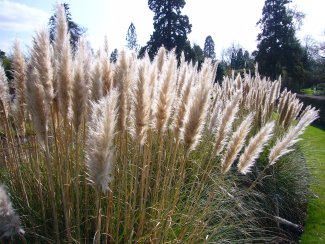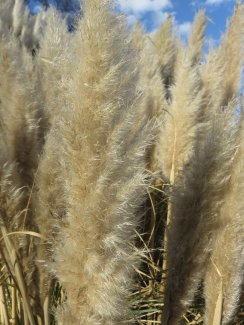PARENT SPECIES is native toSouthern America: Brazil: Brazil - Parana, - Rio de Janeiro, - Rio Grande do Sul, - Santa Catarina, - Sao Paulo Southern South America: Argentina; Chile; Uruguay
FOR THE PARENT SPECIES: HABIT Perennial; caespitose; clumped densely. Culms 100–300 cm long. Ligule a fringe of hairs; 3–5 mm long. Leaf-blades 60–200 cm long; 3–12 mm wide; coriaceous; stiff. Leaf-blade margins scabrous. INFLORESCENCE Dioecious (by loss of viability in bisexual plants), or gynodioecious ("male", in this context, indicating the bisexual state). Inflorescence a panicle. Panicle open; ovate; dense; 25–100 cm long. Spikelets solitary. Fertile spikelets pedicelled. Male spikelets pedicelled. FERTILE SPIKELETS Spikelets comprising 3–7 fertile florets; with diminished florets at the apex. Spikelets lanceolate; laterally compressed; 12–18 mm long; breaking up at maturity; disarticulating below each fertile floret. Floret callus elongated; 0.5 mm long; pilose. GLUMES Glumes similar; shorter than spikelet; similar to fertile lemma in texture; shiny. Lower glume lanceolate; 8–14 mm long; 1 length of upper glume; hyaline; without keels; 1 -veined. Lower glume lateral veins absent. Lower glume apex attenuate. Upper glume lanceolate; 8–14 mm long; 0.7 length of adjacent fertile lemma; hyaline; without keels; 1 -veined. Upper glume lateral veins absent. Upper glume apex attenuate. FLORETS Fertile florets female. Fertile lemma lanceolate; 9–18 mm long; hyaline; pallid, or purple; shiny; without keel; 3 -veined. Lemma surface villous; hairy below. Lemma hairs 4–8 mm long. Lemma apex setaceously attenuate. Palea 0.3 length of lemma; hyaline; 2 -veined. Palea keels scabrous. Apical sterile florets resembling fertile though underdeveloped. FLOWER Lodicules 2; cuneate; fleshy; ciliate. Staminodes present; 0.1–0.3 mm long. MALE Male inflorescence sometimes bisexual similar to female; a panicle. Male spikelets distinct from female (glabrous). FOR THE PARENT SPECIES: Cortaderia selloana, commonly known as pampas grass, is a flowering plant native to southern South America, including the pampas after which it is named.It is a tall grass, growing in dense tussocks that can reach a height of 3 m. The leaves are long and slender, 1 - long and 1 cm broad, with very sharp edges. The leaves are usually bluish-green, but can be silvery grey. FOR THE PARENT SPECIES: This South American grass has been introduced in temperate and subtropical areas mainly as an ornamental. It has also been introduced for erosion control and as a barrier or windbreak. For 'PUMILA': This dwarf cultivar has mid-green leaves and densely tufted plumes atop tall, upright stalks and arching mid-green leaves. Masses of silvery yellow plumes appear in late summer. 'Pumila' is a dwarf pampas grass with huge 18 inch feathery white plumes. The showy, silvery-cream plumes feel silky to the touch and are perfect for use in dried arrangements. Cortaderia 'Pumila' is a very good grower and much more cold hardy than the species. 'Pumila' thrives in hot, full sun exposures and is especially useful as a specimen along walls and in corners.
Its expansion history is well-known for California, USA, where it was first introduced in the mid-1800s by a pioneering nurseryman, Joseph Sexton. The panicles were grown and marketed in the area near Santa Barbara. It was first recognized as naturalized in California in 1929 when a specimen was collected near Los Angeles. Herbarium records indicate that it has expanded since then at approximately 218 km2 per year. Currently, it is present in at least 19 Californian counties, where it has colonized relatively undisturbed native plant communities. Generic analysis of invasive plants indicates that the expansion originated from multiple cultivated gene pools as well as landscape plantings. In New Zealand, it was introduced in the late-1800s and by 1970 it was considered a serious weed in the North Island, covering 12,500 ha in six state forests in the Auckland Conservancy by 1984. In Europe, it was first introduced in the UK from 1775-1862. During the last century, introduction as an ornamental and via landscaping has also occurred in Ireland, Portugal, Spain, France and Italy. Its continuous use as an ornamental and in landscaping can increase its spread in non-invaded areas.

